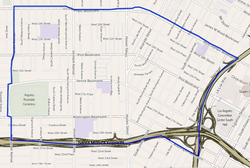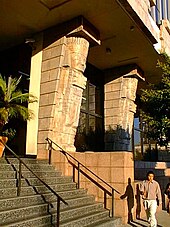Pico-Union, Los Angeles
Pico-Union | |
|---|---|
 The historic Doria Apartments in Pico-Union | |
 Map of the Pico-Union neighborhood of Los Angeles, as delineated by the Los Angeles Times |
Pico-Union is a densely populated, low-income, youthful, 85.4% Latino, mostly immigrant neighborhood in Central Los Angeles, California. Historic in character and undergoing a renewal program, the neighborhood is home to two high schools and seven other schools, as well as a branch public library. It is the site of the long-established private Angelus-Rosedale Cemetery.
Geography
Description
Pico-Union is flanked by Koreatown and Westlake to the north and northeast, Downtown to the east, Adams-Normandie, University Park and Exposition Park to the south and Harvard Heights to the west.[1][2][3][4]
The neighborhood is bounded on the north and northeast by Olympic Boulevard, on the east by the 110 Freeway, on the south by the Santa Monica Freeway and on the west by Normandie Avenue. It also includes the California Highway Patrol station beneath the freeway interchange northeast of Washington Boulevard.[2][3]
Adjacent neighborhoods
Relation of Pico-Union to other communities:[1][3][4]
History


The area encompassed by Pico-Union was developed as a middle and upper middle class residential district beginning in the 1910s. Easy access to downtown Los Angeles and the nearby Wilshire District drew large numbers of affluent homeowners. Following the Second World War, the Pico-Union area, like many inner city neighborhoods, experienced an outflux of residents to the suburbs. The loss of residents and business led to high vacancy rates and lower property values in much of the neighborhood by the 1960s.
In the late 1970s and 1980s, the area became a major point of entry for Salvadoran and Guatemalan immigrants seeking refuge from civil war, according to the Pico Union Self-Guided Walking Tour, published in 2009 by the Los Angeles Conservancy.[5]
Pico-Union became the city's 19th Historic Preservation Overlay Zone on August 10, 2004. It contains two historic districts listed in the National Register of Historic Places: South Bonnie Brae Tract Historic District and Alvarado Terrace Historic District.
In August 2012, the City of Los Angeles designated a portion of Vermont Avenue in Pico-Union as El Salvador Community Corridor; parts of Pico-Union is also being considered to be designated as Central American Historical District.[6]
The former First Church of Christ, Scientist, once one of Jim Jones' Peoples Temples, was located in Pico-Union, at the corner of Alvarado Street and Alvarado Terrace.[7]
Population
Pico-Union is the fourth-most-crowded neighborhood in Los Angeles, surpassed only by East Hollywood, Westlake and Koreatown.[8] The 2000 U.S. census counted 42,324 residents in the 1.67-square-miles neighborhood—an average of 25,352 people per square mile. In 2008, the city estimated that the population had increased to 44,664. The median age for residents was 27, considered young for the city and the county.[2]
The ethnic breakdown in 2000 was: Latinos, 85.4%; Asians, 7.6%; whites, 3.0%, blacks, 2.9%; and others, 1.1%. El Salvador (44.4%) and Mexico (23.3%) were the most common places of birth for the 64.6% of the residents who were born abroad, a figure that was considered high in comparison with foreign-born in the city as a whole.[2] Other immigrants come from Guatemala, Honduras and Nicaragua.[9]
The median household income in 2008 dollars was $26,424, considered low for both the city and the county. The percentage of households earning $20,000 or less was high, compared to the county at large. The average household size of 3.3 people was relatively high for Los Angeles. Renters occupied 90.5% of the housing units, and home- or apartment owners the rest.[2]
The percentages of never-married men (43.4%) and never-married women (36.2%) were among the county's highest. The census found 2,113 families headed by single parents, the 23.3% rate being considered high for both the city and the county.[2]
In 2000 there were 667 military veterans living in Pico-Union, or 2.3% of the population, considered a low rate for the city and the county overall.[2]
These were the ten neighborhoods or cities in Los Angeles County with the highest population densities, according to the 2000 census, with the population per square mile:[10]
- Koreatown, Los Angeles, 42,611
- Westlake, Los Angeles, 38,214
- East Hollywood, Los Angeles, 31,095
- Pico-Union, Los Angeles, 25,352
- Maywood, California, 23,638
- Harvard Heights, Los Angeles, 23,473
- Hollywood, Los Angeles, 22,193
- Walnut Park, California, 22,028
- Palms, Los Angeles, 21,870
- Adams-Normandie, Los Angeles, 21,848
Education




Pico-Union residents aged 25 and older holding a four-year degree amounted to 6.7% of the population in 2000, considered low for both the city and the county, and there was a high percentage of residents with less than a high school diploma.[2]
Schools
These are the elementary or secondary schools within the neighborhood's boundaries:
- West Adams Preparatory High School, LAUSD, 1500 West Washington Boulevard[2]
- SIATech Pico-Union is a public charter high school, 2140 West Olympic Boulevard suite 327. "Classes are held from approximately 9:00 am - 4:00 pm. This site is an independent study school where students complete work at home, online and on site."[11]
- Loyola High School of Los Angeles, private, 1901 Venice Boulevard[2]
- Berendo Middle School, LAUSD, 1157 South Berendo Street,[2] which claims the title as the oldest intermediate school continuously in operation in Los Angeles and perhaps in the entire United States
- Sophia T. Salvin Special Education Center, LAUSD, 1925 Budlong Avenue[2]
- Leo Politi Elementary School, LAUSD, 2481 West 11th Street[2]
- Tenth Street Elementary School, LAUSD, 1000 Grattan Street[2]
- Saint Thomas the Apostle School, private elementary, 2632 West 15th Street[2]
- Magnolia Avenue Elementary School, LAUSD, 1626 South Orchard Avenue[2]
- Los Angeles Christian School, private, 1630 West 20th Street[2]
Public library
Los Angeles Public Library operates the Pico-Union Branch Library at 1030 South Alvarado Street.[12]
Cemetery
Angelus-Rosedale Cemetery was founded as Rosedale Cemetery in 1884, when Los Angeles was a small city of around 28,000 people, on 65 acres (260,000 m2) of land between Washington and Venice boulevards (then 16th Street) between Normandie Avenue and Walton and Catalina Streets.[13][14]
Notable people
- Elizabeth Harrower (1918 - 2003), actress, writer
- Jim Jones, founder and the leader of the Peoples Temple
- Jacob Kuhrts, sailor, miner, teamster, merchant, volunteer fire chief and member of the Los Angeles, California, Common Council, the governing body of that city, during the 19th Century
- Pomeroy Wills Powers, president, Los Angeles City Council, 1900–02
- Susan Seaforth Hayes, actress
- Hip-hop group Psycho Realm
See also
- List of districts and neighborhoods of Los Angeles
- Alvarado Terrace Historic District
- Curacao Department Store, 1605 W. Olympic Boulevard at Union Avenue
- History of the Central Americans in Los Angeles
References
- ^ a b [1] "Central L.A.," Mapping L.A., Los Angeles Times
- ^ a b c d e f g h i j k l m n o p q [2] "Pico-Union," Mapping L.A., Los Angeles Times
- ^ a b c The Thomas Guide, 2006, pages 633 and 634
- ^ a b [3]"South L.A.," Mapping L.A., Los Angeles Times
- ^ Pico Union Self-Guided Walking Tour, 2009
- ^ Shyong, Frank (September 9, 2012) "L.A. Salvadoran Community Sees Hope Along a New Corridor Los Angeles Times
- ^ Los Angeles Peoples Temple
- ^ [4] "Density," Mapping L.A., Los Angeles Times
- ^ Antonio Olivo, "Learning From a Community’s Hard Work," Los Angeles Times, October 2, 1999, pageB-1
- ^ "Population Density". Los Angeles Times. Mapping L.A. Retrieved June 12, 2016.
- ^ http://www.siatechschools.org/schools/california/pico-union/
- ^ [5] Los Angeles Public Library
- ^ Los Angeles Times, Nov. 20, 1884, "Rosedale—The Opening of a New Cemetery in this City," p. 0_4
- ^ "Los Angeles County History - An Illustrated History of Southern California - Los Angeles City". CalArchives4u.com. 1890. Archived from the original on 2008-03-11. Retrieved 2008-04-11.
{{cite web}}:|first=missing|last=(help)CS1 maint: multiple names: authors list (link)
External links
- [6] Comments about living in Pico-Union
- [7] Pico-Union crime map and statistics
- [8] Map of Street Gangs in Pico-Union Neighborhood
- [9] Project One, Community Redevelopment Agency
- [10] Project Two, Community Redevelopment Agency
- [11] LA City Office of Historic Resources
- [12] Historic Preservation Plan
- [13] The Graff Lab
- [14] The King of Pop Michael Jackson Mural "MJ2010," MJFanClub.net
